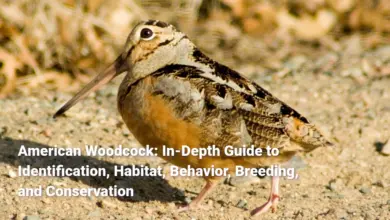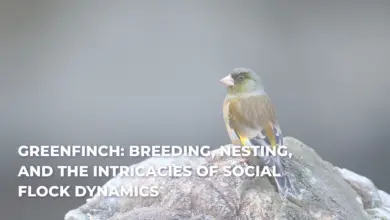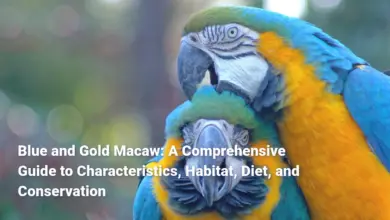Tree Sparrow: Habitat, Diet, Breeding, and Conservation
When one thinks of sparrows, visions of small, unassuming birds flitting about might come to mind. However, the tree sparrow, particularly the Eurasian tree sparrow (Passer montanus), offers a captivating blend of charm and adaptability that merits a closer examination. These birds, commonly found across a broad spectrum of habitats, including urban areas, farmlands, and even coastal cliffs, not only embody resilience but also contribute significantly to their ecosystems. Despite their small stature, ranging from 14 to 16 centimeters in length, tree sparrows possess distinct features that allow them to thrive in various environments and showcase a range of behaviors that hint at their evolutionary success. As we embark on this in-depth exploration of the tree sparrow, we will delve into their habitats, diets, breeding habits, social structures, and the challenges they face in today’s rapidly changing world.

Understanding the intricacies of tree sparrows is not merely an academic endeavor; it is essential in fostering respect for the biodiversity surrounding us. By appreciating these fascinating creatures, we gain insight into broader ecological dynamics and the essential roles these birds play within their environments. From their migratory behaviors to their essential contributions in seed dispersal, tree sparrows exemplify how even the smallest of creatures have significant impacts. So without further ado, let us unfold the fascinating life of the tree sparrow and understand their world in greater detail.
Habitat of the Tree Sparrow
The habitats preferred by tree sparrows can be as varied as the stunning landscapes they inhabit. Ranging from urban regions to agricultural areas, the Eurasian tree sparrow (Passer montanus) especially shows a preference for landscapes that offer both cover and food sources. Their inclination toward open farmland with mature deciduous trees is indicative of their adaptability; they thrive in environments resembling a well-balanced plate, where shelter and nourishment are equally present.
In contrast to the American tree sparrow (Spizelloides arborea), which finds solace in the expansive treeless tundra of the Arctic, the Eurasian tree sparrow exhibits a chosen complexity in habitat. While the American counterpart prefers the scruffy edges and open fields, especially during foraging activities in winter, the Eurasian species seeks out places rich in human presence, often opting for old trees, hedges, and farm buildings as nesting materials.
To illustrate the preferred environments of these species, consider the following comparisons:
| Feature | Eurasian Tree Sparrow (Passer montanus) | American Tree Sparrow (Spizelloides arborea) |
|---|---|---|
| Primary Habitat | Open farmlands with mature deciduous trees | Treeless tundra, scrubby areas above treeline |
| Nesting Areas | Tree holes, farm buildings, nest boxes | Ground nests in tussocks of grass or shrub bases |
| Preferred Seasons | Year-round presence, with winter adaptations | Breeds in summer, migratory in winter |
In synthesizing this information, it becomes evident that the adaptation to diverse habitats has been a critical feature of the tree sparrow’s survival toolkit. Whether through urban adaptability or the ability to locate the right mix of resources in rural settings, these birds continue to charm all who take the time to observe their behaviors.
Preferred Environments
Tree sparrows demonstrate exceptional adaptability as they shift between different environments and habitats, a characteristic crucial for their survival. Open farmland has become a favorite of the Eurasian tree sparrow due to its expansive land peppered with trees that provide suitable nesting sites. Commonly seen flitting between hedgerows and foraging through agricultural fields, the tree sparrow’s presence signifies a thriving ecosystem where agriculture does not exclusively dominate.
Conversely, the American tree sparrow thrives in the fresh air of the tundra, showcasing its capabilities in cold, windswept fields. Their breeding hearths are often situated in scrubby areas that provide shelter from the elements. The choice of nesting in tussocks keeps them close to the ground, offering a protective barrier against potential predators that might jeopardize their young.
In summary, the preferred environments of these tree sparrows correlate strongly with their feeding habits and nesting requirements. While the Eurasian tree sparrow prefers a setting rich in human activities, utilizing farmland, trees, and buildings, the American tree sparrow showcases a unique affinity for natural landscapes devoid of overdevelopment. Each chooses its surroundings based on the presence of adequate food and protection, which defines their existence.
Geographic Distribution
The geographic distribution of tree sparrows adds another layer of complexity to their ecological narrative.
- Eurasian Tree Sparrow (Passer montanus)
- This elusive bird boasts an extensive breeding range, spanning from temperate Eurasia to regions of Southeast Asia. Sociable by nature, the Eurasian tree sparrow often finds a home near human settlements, particularly in urban habitats. Here it’s not unusual for them to frequent parks, gardens, and even feed from bird stations near homes and businesses. Their sedentary nature in most regions is contrasted by migratory tendencies observed in more northern populations that seek warmth during winter, enhancing their adaptability.
- American Tree Sparrow (Spizelloides arborea)
- Concentrated predominantly in the North American tundra and the northern limits of the boreal forest, the American tree sparrow embraces solitude amidst the wild. These birds breed in cooler climates, primarily across Alaska and Canada, and use their adaptability to forage in various open habitats. As winter approaches, they migrate south into parts of Canada and the northern United States, positioning themselves within grasslands and shrublands where food is plentiful.
The following table summarizes the geographic distribution of the two tree sparrow species:
| Species | Geographic Range | Habitat Preference |
|---|---|---|
| Eurasian Tree Sparrow | Europe, Asia, North Africa, urban environments | Farmland, urban areas, coastal cliffs |
| American Tree Sparrow | Alaska, northern Canada, wintering in parts of Canada, northern US | Tundra, open fields, shrublands |
The geographic adaptations of these sparrow species reveal their resilience in different ecological contexts. By occupying a range of habitats, they maximize their chances of survival through diverse foraging and nesting behaviors.
Diet and Feeding Behavior
The diets of tree sparrows can be characterized by their opportunistic nature, allowing them to thrive as granivores. Their feeding behavior is closely connected to their habitats and the seasonal availability of food sources.
The Eurasian tree sparrow predominantly feeds on seeds, grains, and invertebrates. Their dietary preferences align with what is available in their surroundings; they favor seeds from grasses and grains, especially during autumn and winter, when they seek sustenance in stubble fields. With their knack for adjusting to prevailing food conditions, they also visit bird feeders, adding variety to their diet with peanuts and other high-calorie seeds. Additionally, their reliance on animal protein during spring and summer is essential for raising their young, as they need to incorporate insects into their diet during that time.
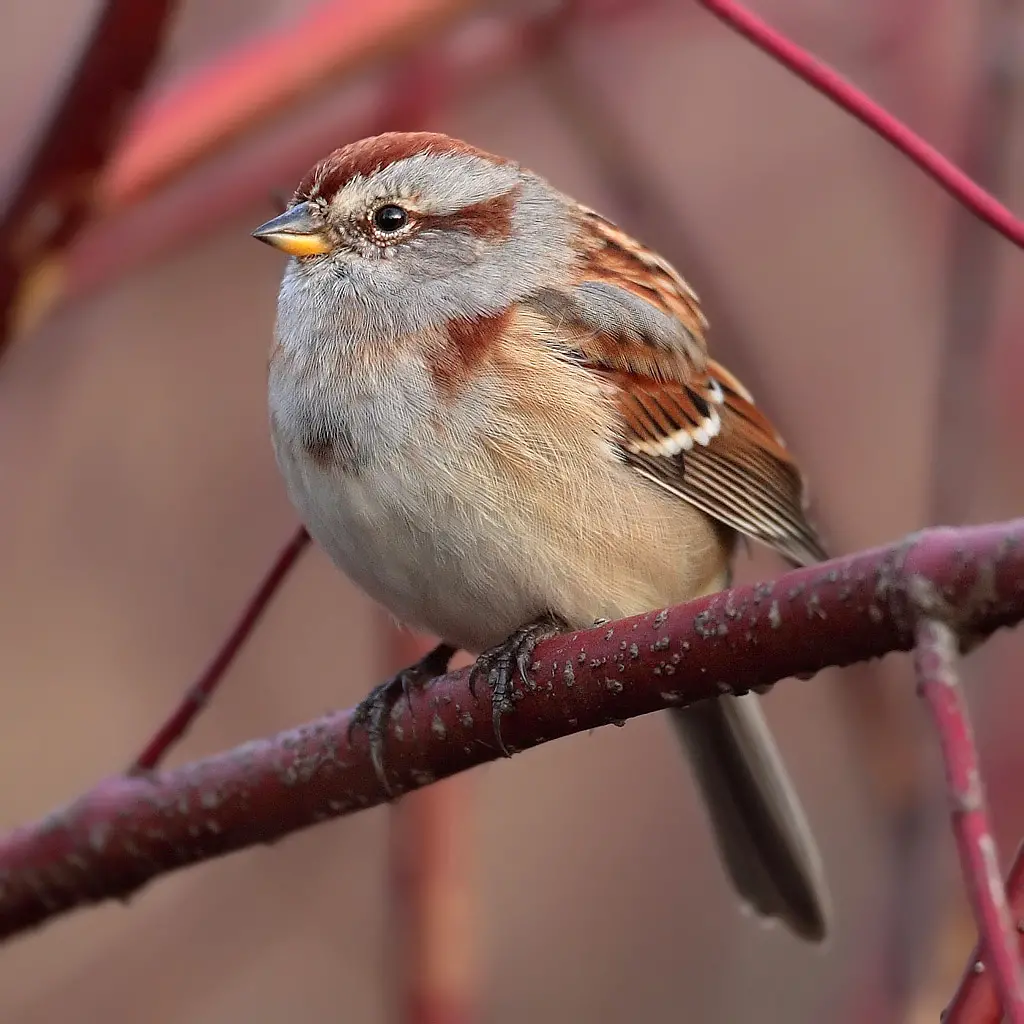
In contrast, the American tree sparrow showcases a seasonal dietary shift that reflects its adaptability. In the winter months, they’re found scavenging for seeds in open fields and brushy areas, while during the breeding season, they pivot to a diet rich in insects. Their ground foraging habits enable them to achieve this, often foraging in flocks, promoting feeding efficiency through collaboration, as flock members guide one another toward food resources.
Primary Food Sources
The primary food sources available to tree sparrows reaffirm their opportunistic feeding strategies.
- Seeds and Grains:
- Both species rely significantly on seeds and grains for sustenance. Eurasian tree sparrows favor seeds from grasses and weeds, while American tree sparrows adapt to varied seed sources, from sunflower seeds to millet. The seasonal shifts in food availability dictate their foraging behaviors, especially during winter when supplemental feeding stations become essential.
- Insects and Arachnids:
- During the breeding season, tree sparrows increase their consumption of insects to meet the protein needs of their chicks. A variety of insects, including beetles, caterpillars, and spiders, serve as critical food sources, particularly during the early stages of a chick’s development.
- Fruits and Berries:
- Working into their seasonal diet, tree sparrows also ingest fruits and berries, taking advantage of available carbohydrates that aid in energy. This dietary diversity allows them to flourish and adapt efficiently to their surroundings.
These varied food sources demonstrate the remarkable dietary flexibility of tree sparrows, positioning them as successful foragers irrespective of seasonal changes.
Foraging Techniques
The foraging techniques employed by tree sparrows illustrate their adaptability and resilience in diverse environments.
- Ground Foraging: Tree sparrows thrive as ground foragers, utilizing their strong legs and conical bills to search for food directly on the ground. This method allows them to uncover hidden seeds and insects effectively.
- Mixed-Species Flocking: In their quest for food, tree sparrows often join forces with other bird species. This behavior enhances their foraging efficiency and improves success rates by relying on the vigilance of nearby birds to spot potential threats.
- Scratching and Probing: Their adeptness at scratching and probing the ground to unveil hidden morsels beneath leaves and debris contributes to their success as well. Their anatomical build empowers them to engage in this behavior effectively.
- High Mobility: As agile fliers, tree sparrows can easily hop between feeding patches, retreating to cover if they sense danger. Their ability to move swiftly enhances their chances of survival, particularly in predator-rich areas.
In conclusion, the diverse foraging techniques of tree sparrows, coupled with their opportunistic dietary behaviors, not only reflect their innate adaptability but also their thriving presence in various habitats. This adaptability is fundamental for their long-term survival as they navigate the challenges posed by changing environments.
Breeding and Nesting Habits
The breeding and nesting behaviors of tree sparrows embody the essential traits that lead to successful reproduction. Each species exhibits distinct patterns in nesting, with the Eurasian tree sparrow often exhibiting colonial nesting habits, while the American tree sparrow generally opts for ground nests.
During the breeding season, which for the Eurasian species occurs from April to August, these birds invest in their reproductive cycles to ensure the survival of their young. They prefer to nest in tree cavities, old buildings, or man-made housing, creating a safe environment for their offspring. The materials used in nest construction, such as grass and feathers, provide insulation for the developing chicks.
In contrast, the nesting habits of the American tree sparrow reveal a preference for simplicity as they typically build their nests on the ground amidst tussocks of grass. Though less complex, their nests are crafted from materials like moss, grasses, and shreds of bark, designed to keep their chicks warm and protected.
Nest Construction
Nest construction in tree sparrows is fascinating and reflects both species’ adaptations to their respective environments.
- Eurasian Tree Sparrow (Passer montanus): These birds typically take four to seven days to build nests. They craft their nests in colonies, choosing tree holes, willow pollards, and farm buildings. Insulation from materials such as hay and feathers is crucial for maintaining appropriate temperatures for their young. The entrance holes to their nests measure at least 2.8 cm in diameter, providing a secure yet accessible point for adult birds to enter.
- American Tree Sparrow (Spizelloides arborea): The American species exhibits a more straightforward approach to nesting than its Eurasian counterpart. They prefer to construct their nests on or close to the ground. Using grass and moss snugly woven together, these nests provide warmth and shelter for the altricial, helpless chicks. The building process is keenly timed to coincide with the availability of nesting materials, often completed in just a few days before egg-laying begins.
The nesting techniques exhibited by both species emphasize their adaptability and instinctual understanding of their environmental needs. By utilizing available materials efficiently, they create secure environments in which their young can thrive.
Reproductive Cycle
The reproductive cycle of tree sparrows showcases various stages integral to their species’ survival.
- Breeding Season and Clutch Size: Tree sparrows generally start laying eggs from late April to August, with peak activity in May. A typical tree sparrow pair can produce two to three well-timed broods each summer, utilizing the available food to nurture up to seven eggs in a single clutch.
- Nest Building: Both male and female tree sparrows actively participate in building their nests, gathering materials that ensure insulation and protection. This collaborative effort solidifies their pair bonds while promoting a safe environment for their young.
- Chick Development: Once the chicks hatch, they are entirely dependent on their parents for nutrition and protection. Eagerly awaited by their parents, the fledging age reaches approximately 14 to 20 days, after which the fledgling continues to receive care and guidance from their parents.
The reproductive cycle of tree sparrows illustrates their commitment to breeding and nurturing their young. The cooperative behaviors displayed among adult partners enhance their chances of raising healthy offspring that can thrive in their ecological niches.
Social Structure and Behavior
Tree sparrows thrive in social structures that foster cooperation and protective behaviors within their communities. Being social birds, they prefer to live in colonies, with individuals often coming together outside the breeding season to forage and roost communally.
Flocking Patterns
The flocking behavior exhibited by tree sparrows enhances their survival and adaptability. This behavior is predominantly driven by three key factors: safety in numbers, better feeding efficiency, and social interactions. During winter, they often form sizable flocks that contribute to their collective well-being.
- Safety in Numbers: This structure serves an important purpose, as larger flocks can deter potential predators and increase the likelihood of spotting threats from afar. Alarm calls alert group members of danger, allowing them to respond promptly.
- Feeding Efficiency: The social dynamics within these flocks can lead to increased foraging success. Birds often exchange information about food sources, allowing inexperienced members to learn from more experienced ones.
- Social Interactions: The flocking patterns further enhance social bonds among individuals, facilitating the establishment of hierarchies and relationships within the group. This dynamic interaction is vital for the overall success of tree sparrows in navigating their environments.
Interaction with Other Bird Species
American tree sparrows display fascinating social interactions with other species, particularly during the winter months when they congregate in mixed-species flocks.
- Foraging Behavior: These mixed flocks often comprise various songbirds, allowing different species to benefit from collective vigilance. By flocking together, birds can cover more ground more effectively.
- Mutualistic Relationships: The coexistence of tree sparrows with other bird species leads to improved food-seeking behaviors and heightened safety from predators, illustrating the interconnectedness within the avian community.
Through such communal strategies and partnerships, tree sparrows exemplify the wisdom of collaborative living, as they navigate their environments optimally with the aid of one another.
Conservation Status and Threats
As we draw attention to the conservation challenges faced by tree sparrows, it is essential to understand the multiple factors contributing to their decline and assess their ecological importance.
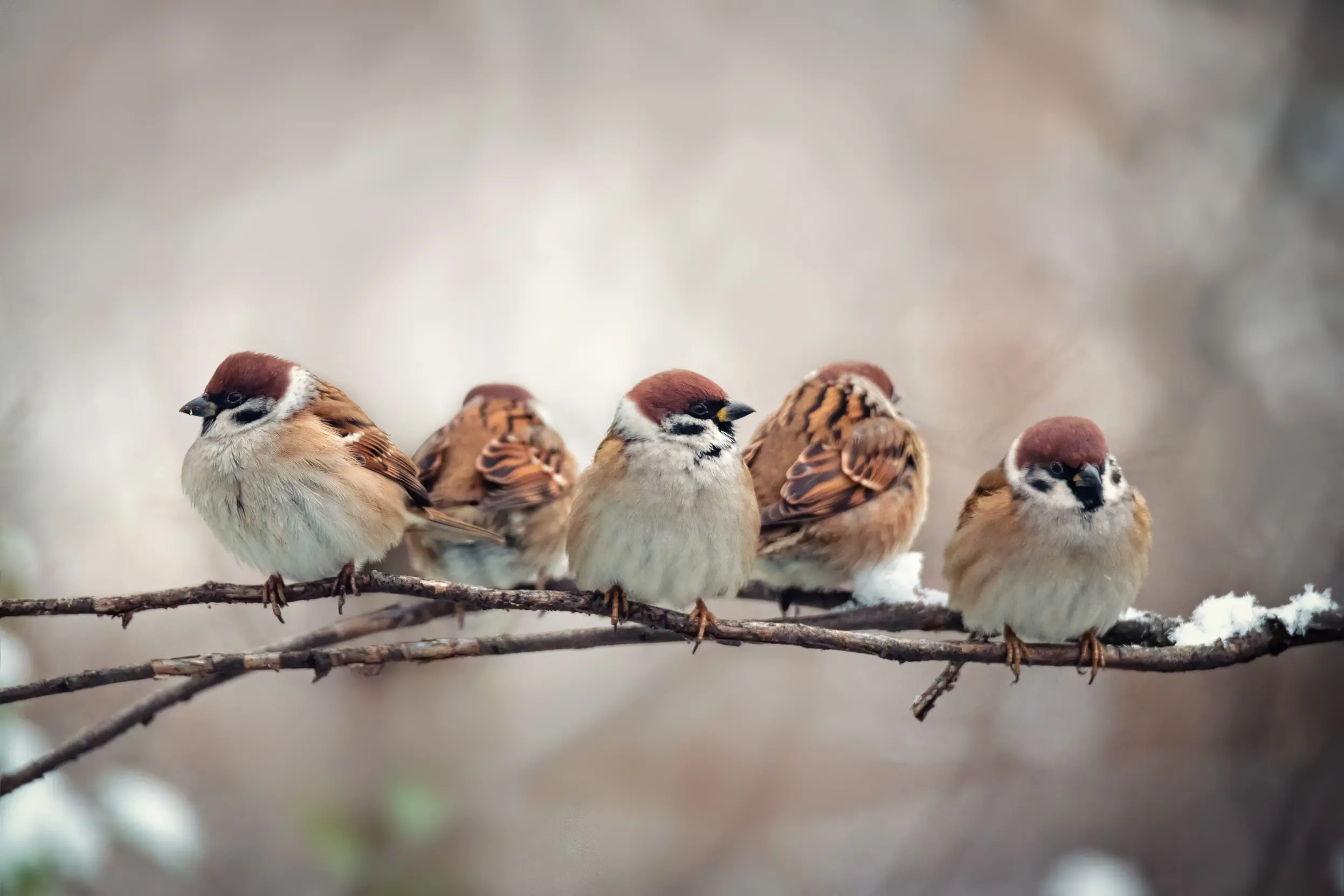
Population Trends
Current population estimates indicate that the American tree sparrow is classified as “Least Concern” on the IUCN Red List, yet significant declines are observed, particularly in southern regions. Between 1970 and 2014, the average population decreased by approximately 1.8% per year. These population dynamics highlight the ongoing challenges and implications of habitat alteration and climate change on tree sparrow survival.
Key Threats to Survival
The survival of tree sparrows is threatened by several key factors, including:
- Agricultural Practices: The transition to industrial agriculture has led to a loss of the diverse landscapes that tree sparrows rely on for food and nesting. Monocultures limit their access to an array of seeds and insects.
- Habitat Loss and Fragmentation: As urbanization continues to encroach on natural habitats, tree sparrows face increased pressure from habitat loss. The reduction of hedgerows and tree cover disrupts their nesting areas and impacts food availability.
- Climate Change: Shifting temperatures and altered weather patterns challenge tree sparrows by impacting their food sources and breeding success. This undermines their reproductive cycle and resilience.
- Predation: Increased predation, especially in suburban settings where domestic cats are prevalent, also poses a serious threat to fledglings and nesting adults.
- Population Metrics: The decline in Tree Sparrow populations indicates serious conservation challenges, particularly highlighted by a staggering 93% reduction in the UK between 1970 and 2008, earning them a red conservation rating.
Importance in Ecosystem
The role of tree sparrows extends beyond their charming presence; they act as vital components within their ecosystems.
Role as Seed Dispersers
As primarily granivorous birds, tree sparrows facilitate seed dispersal, which is critical for maintaining diverse plant communities.
- Ecosystem Functionality: Their foraging activities promote the establishment and survival of various plant species, contributing to ecosystem regeneration after disturbances.
- Biodiversity Contribution: By dispersing seeds, they enhance plant diversity, which is essential for resilience against pests and diseases.
- Nutrient Cycling and Soil Health: Their role in stimulating plant growth influences soil health, ultimately benefiting a myriad of organisms that depend on the vitality of their environment.
Contribution to Biodiversity
Tree sparrows’ influence extends further into biodiversity, contributing actively to the regeneration of ecosystems and serving as critical links in food webs.
- Nutrient Exchange: Their behaviors support nutrient cycling, leading to healthier plant communities and soil ecosystems.
- Mutualistic Relationships: The reciprocal relationship between tree sparrows and the plants they consume exemplifies ecological interdependence, where both parties benefit from shared existence.
In summation, tree sparrows are not merely charming avian ambassadors; their contributions to ecosystem dynamics are essential for fostering balanced interactions among species and promoting overall biodiversity. Their role as seed dispersers and their presence in mixed flocks underscore their importance in functioning ecosystems.
As we navigate the future, recognizing the critical need for conservation efforts aimed at protecting tree sparrows and their habitats is paramount for maintaining ecological integrity and supporting the vibrant web of life within our environments.
In conclusion, the tree sparrow is a notable species exemplifying adaptability and resilience in the face of environmental challenges. Their fascinating life, behaviors, and interactions within ecosystems highlight not only their unique character but also the broader implications of preserving biodiversity. Understanding the needs and roles of tree sparrows in our ecosystems fosters a deeper connection to nature, revealing the interconnectedness of all species. Continuous conservation efforts and public awareness are essential in ensuring that these remarkable birds continue to thrive for generations to come.






